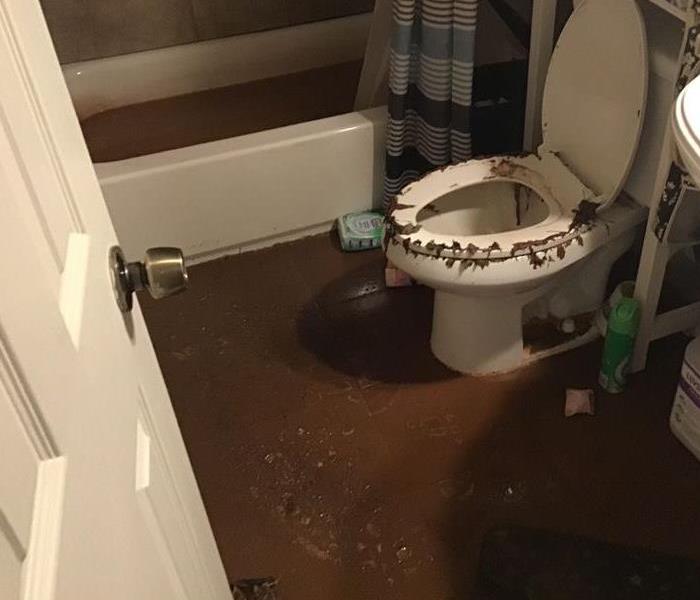Commercial Water Damages As A Result Of Toilet Overflow: What To Do And What Not To Do
8/17/2020 (Permalink)
Toilet overflow is something that nobody intends to consider, and that the majority of us do not. It's much more than a minor inconvenience when it takes place from either an effective pipeline or a stuck toy, especially when the damages are on an upper floor and filled with contaminated category 2 or 3 water.
When facing water damages from toilet overflow, you are required to ensure that you take the appropriate actions to prevent further destruction to your property and health and wellness of your staff and residents.
How Toilet Overflow Can Damage Your Commercial Property?
Depending upon the layout as well as the location of the washroom within your residence, water from an overflowing toilet can permeate into or completely damage:
- Drywall
- Electrical wiring
- Flooring/baseboards
- Ceilings of lower level rooms
- Shower tiling
- Bathtubs
- Door trims
- Cupboards
- Carpets
- Any type of uninsulated areas, like below cabinets
How Is Water Damage is Assessed?
As soon as you call an expert water restoration company such as SERVPRO to look at the affected area, they will evaluate the damages based upon the quality of the water and the class of the loss.
There are 3 categories of water quality:
Category 1, also known as clean water, is sanitary water that does not present a threat to health; this generally originates from a busted water supply line.
Category 2, also known as greywater, is water that has been contaminated to some extent and can cause illness.
Category 3 (" black water") is the most harmful and consists of raw sewage, fungus, bacteria, as well as various other microbes that can trigger extreme health issues.
On top of that, there are four classes of water loss, depending on the magnitude of damages:
Class 1 water damage is when only low-porosity and also low-permeability materials in the area are impacted. Including materials like linoleum, wood floorings as well as fixtures, and floor tile.
Class 2 water damage is when the water has impacted the entire room/area of your property; consisting of structures and up to 2 feet of water infiltration up any wall surfaces.
Class 3 water damage is when essentially all of the areas have been saturated with the overflowing water. Ceilings, insulation, structures, furnishings, cushions, carpets, and much more, are impacted.
Class 4 water damage is when low-porosity, low-permeability materials like concrete, stone, and also hardwood are saturated. Considering that the water can get caught in hard-to-reach pockets, they vaporize much more slowly as well as call for unique strategies to completely dry.
DO's and DON'TS of Handling Toilet Overflow
DO get in touch with an expert company as well as your insurance provider immediately.
Even if you're insured for water damage, several insurance companies include a mitigation clause that requires you to prevent additional damage. If you do not promptly hire a professional to evaluate the problem, your insurance might decline your coverage. SERVPRO of North Fulton is readily available 24/7 to react to your needs, begin repair services, and instantly assist you with the insurance case process.
DO work with a trusted expert to rebuild the water-damaged areas of your property.
Even if you have experience in commercial construction, do not take care of the impacted areas on your own, especially if your property was constructed before 1980. property owners that attempt to demolish damaged drywall on construction before 1980 might be exposed to asbestos. Lastly, ensure that the business is IICRC certified as well as updated on training.
DO NOT attempt to clean up the flooding on your own.
Category 2, as well as 3 water, is dangerous for you and your loved ones' health and wellness. Furthermore, temporarily being exposed to the pathogens can result in illness. Contain the water if you can, however, ensure to steer clear of the affected area until professionals show up.
DO NOT assume that there are no damages due to the fact that it isn't immediately noticeable.
Considering that the full extent of the damages commonly isn't visible to the naked eye, many property owners think that there isn't any kind of damages and commonly fail to obtain professional aid before things get even worse. If your bathroom is on an upper level, this could lead to a collapse in the lower level ceiling.
DO NOT ventilate the area before help arrives. While it might help reduce odors and dry the area, it also spreads out any possible microorganisms throughout your property.
Conclusion
At SERVPRO of North Fulton, we understand how discouraging it can be to navigate the restoration process to your property after water damage. If you're a Sandy Springs property manager dealing with the impacts of toilet overflow or any other commercial flooding, we're here to provide you with the quick service you deserve.
Call us at (770) 992-2777





 24/7 Emergency Service
24/7 Emergency Service
